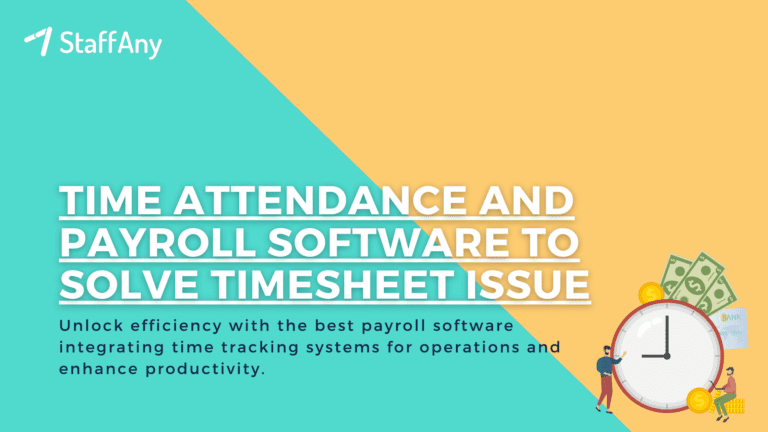As an F&B business owner or manager, one of the most important aspects of running a successful operation is scheduling your employees effectively. Creating a schedule that meets your business needs while also ensuring your staff is happy and productive can be challenging. However, by following a few simple steps, you can create an employee schedule that works for everyone. In this article, we will explore the importance of employee schedules, employee work schedule type, and the best-tips on how to make a schedule.
What is Work schedules?
A work schedule is a predetermined arrangement of working hours and days for employees within an organization. It outlines the specific times and days employees are expected to be present at their workplace and perform their job duties.
Work schedules are essential for organizing tasks, managing workforce availability, and ensuring the smooth operation of businesses in various industries.
Work schedules typically include the following details:
Shift Timing: The specific start and end times of an employee’s workday, indicating when they are expected to begin and finish their work tasks.
Workdays: The days of the week an employee is scheduled to work. Common workweeks consist of five consecutive days (Monday to Friday) or six consecutive days (Monday to Saturday), but variations exist based on the nature of the job and industry.
Breaks and Meal Times: Scheduled breaks and meal periods within the workday. These breaks are essential for rest and maintaining productivity.
Rotation Patterns: For jobs with multiple shifts, the schedule might include rotation patterns, specifying how often employees switch between morning, afternoon, and night shifts.
Overtime and Extra Hours: Details about overtime work, indicating if employees are required or allowed to work beyond their regular hours. Overtime pay rates and policies are also often included.
Days Off: The days when employees are not required to work, providing time for rest, personal activities, and maintaining a healthy work-life balance.
Work schedules can be fixed, meaning they remain constant week after week, or they can be flexible, allowing adjustments based on demand and employee preferences. Flexible work schedules might include options such as part-time work, compressed workweeks, staggered hours, or remote work arrangements.
Employers use work schedules to ensure adequate staffing levels, meet customer demands, and comply with labor laws and regulations. Effective scheduling helps businesses optimize their workforce, enhance productivity, and improve employee satisfaction by promoting a predictable and manageable work routine.
Read more: 10 Critical Employee Scheduling Problems and How to Solve Them
Why is There a Need for a Restaurant Schedule?

Why is there a need for a restaurant schedule? The answer is simple: to ensure smooth operations and customer satisfaction. Here are three reasons why creating a schedule for employees in an F&B business is crucial:
1. Optimise Staffing
Creating a schedule for employees allows you to optimise staffing levels. By scheduling the right number of employees for each shift, you can ensure that you have enough staff to handle busy periods and are not overstaffed during quieter times. This can help you reduce labour costs while ensuring that your customers are always receiving quality service.
2. Increase Efficiency
A well-planned schedule can increase efficiency in your F&B business. By assigning roles and responsibilities to each employee, you can ensure that everyone knows what they need to do and when. This can reduce confusion and delays, leading to faster service and happier customers.
3. Boost Employee Morale
Creating a schedule that is fair and equitable can boost employee morale. When employees feel like they are being treated fairly, they are more likely to be engaged and productive. This can lead to better service and happier customers, as well as reduced turnover rates and higher employee satisfaction.
Read more: 12 Employee Engagement Activities to Keep Them Motivated
What are the Types of Work Schedules?
There are several types of work schedules, each designed to meet the specific needs of employers and employees. Here are some common types of work schedules along with examples and explanations:
1. Full-Time
Example: Working 9:00 AM to 5:00 PM, Monday to Friday.
Explanation: Full-time employees typically work around 35 to 40 hours per week, often following a consistent schedule from week to week. They may receive benefits such as health insurance, paid time off, and retirement plans.
2. Part-Time
Example: Working 20 hours per week, flexible hours.
Explanation: Part-time employees work fewer hours than full-time employees. Their schedules can vary widely and might include evening or weekend hours. They receive pro-rated benefits based on the number of hours they work.
3. Shift Work
Example: Rotating shifts, such as morning (7:00 AM – 3:00 PM), evening (3:00 PM – 11:00 PM), and night (11:00 PM – 7:00 AM).
Explanation: Shift work involves employees working different shifts during a 24-hour period. This schedule is common in industries that require continuous operations, such as healthcare, manufacturing, and customer service.
4. Flexible Hours
Example: Flexible start and end times, as long as employees complete a set number of hours (e.g., 10:00 AM – 6:00 PM or 7:00 AM – 3:00 PM).
Explanation: Flexible hours allow employees to vary their start and end times within certain limits. This schedule provides employees with greater control over their work-life balance.
5. Compressed Workweek
Example: Working four 10-hour days (e.g., Monday to Thursday, 8:00 AM – 6:00 PM).
Explanation: A compressed workweek allows employees to work a full-time schedule within fewer than five days. By working longer hours on fewer days, employees can enjoy extended weekends.
6. Remote or Telecommuting
Example: Working from home or another remote location.
Explanation: Remote work allows employees to perform their job duties outside the traditional office setting, often using digital technologies to stay connected with colleagues and employers. Remote work can be full-time, part-time, or occasional, depending on the employer’s policies.
7. On-Call
Example: Being available to work when needed, without a fixed schedule.
Explanation: On-call employees are available to work at short notice. They might not have fixed working hours and are typically called in to cover unexpected shifts or busy periods.
These are just a few examples of work schedules, and many workplaces use variations or combinations of these schedules to accommodate the needs of their employees and the demands of the business. The choice of work schedule often depends on the nature of the job, industry requirements, and the preferences of both employers and employees.
Read more: 11 Factors to Consider When Scheduling Staff
How to Create a Schedule for Employees in F&B Business
Now that you understand why a schedule is essential in your F&B business, let’s discuss how to create one.
1. Determine Your Business Needs
The first step in creating a schedule for your employees is to determine your business needs. You need to know how many employees you need at any given time to provide excellent customer service. Look at your sales data to determine your busiest times and plan your schedule accordingly. You may also need to factor in other considerations, such as employee availability, vacation time, and training needs.
2. Choose Your Scheduling Software
Once you have determined your business needs, it’s time to choose your scheduling software. There are several options available, including Excel spreadsheets, Google Sheets, and specialised scheduling software. Whatever software you choose, make sure it is easy to use and can handle your business’s specific scheduling needs.
3. Assign Shifts and Roles
Now that you have determined your business needs and chosen your scheduling software, it’s time to assign shifts and roles to your employees. Consider factors such as employee availability, skill level, and job preferences when assigning shifts and roles. You should also strive to create a schedule that is fair and equitable, giving each employee an equal share of shifts.
4. Communicate the Schedule to Employees
Once you have created your schedule, it’s important to communicate it effectively to your employees. Make sure each employee knows when they are scheduled to work and what their role will be during each shift. Consider using a communication tool such as Slack or WhatsApp to make it easy for employees to ask questions or request changes.
Read more: How to Establish Effective Workplace Communication
5. Balance Workload
Ensure a fair distribution of busy and slow shifts among employees. Avoid overburdening certain staff members with consistently busy shifts while others have lighter schedules.
6. Plan for Breaks
Schedule breaks and meal times in compliance with labor laws and regulations. Proper rest periods are crucial for employee well-being and productivity.
7. Consider Employee Constraints
Take into account any constraints your employees might have, such as transportation limitations or other jobs. Be mindful of these constraints while creating the schedule.
8. Be Flexible schedule
Stay open to last-minute changes and unexpected situations. Having contingency plans for emergencies ensures that operations continue smoothly even in unforeseen circumstances.
Read more: Understanding Employee Management System and Its Benefits
9. Rotate Shifts Fairly
If applicable, implement fair shift rotation policies to distribute morning, afternoon, evening, and weekend shifts equitably among employees. This fosters a sense of fairness and teamwork.
10. Regularly Review and Adjust
Regularly review the schedule’s effectiveness. Collect feedback from both employees and managers to identify areas for improvement. Be willing to make adjustments based on feedback and changing business needs.
11. Empower Employees
Consider involving employees in the scheduling process. Some businesses allow employees to indicate their preferred shifts, which can be factored into the scheduling process, enhancing their job satisfaction.
12. Plan Ahead
Create schedules well in advance, preferably at least two weeks prior to the start of the new schedule period. This provides employees with ample time to plan their personal commitments around work.
By implementing these tips, you can create a balanced and efficient schedule that meets the needs of your F&B business while ensuring employee satisfaction and well-being.
Read more: Shift Working Hours in Malaysia: Guidelines and Useful Tips
How to Prevent Poor Scheduling
Creating an effective employee schedule is critical for the success of your F&B business. However, poor scheduling can lead to decreased employee satisfaction, increased turnover, and decreased productivity. Here are a few tips to help you prevent poor scheduling.
1. Use Employee Feedback
One of the best ways to prevent poor scheduling is to use employee feedback. Ask your employees for their input on the schedule, including their availability, preferences, and any concerns they may have. Consider implementing a system where employees can request changes to the schedule, and try to accommodate these requests whenever possible.
2. Monitor Your Schedule
Another way to prevent poor scheduling is to monitor your schedule regularly. Keep track of employee absences, sick days, and other scheduling issues to identify patterns and make adjustments as necessary. Consider using employee scheduling software that can alert you to scheduling conflicts and help you make changes quickly.
Read more: Understanding Manpower Planning and Its Importance in F&B
3. Consider Employee Availability
When scheduling employees, it’s important to consider their availability. Make sure you take into account any time off requests or scheduling conflicts when creating the schedule. This can help prevent scheduling issues and ensure that employees are happy with their schedules.
4. Be Fair and Equitable
Creating a fair and equitable schedule is important for keeping employees happy and reducing turnover. Make sure each employee has an equal share of shifts, and consider rotating shifts to ensure that everyone has a chance to work during peak periods. Also, try to accommodate employee preferences as much as possible.
Read more: Understanding How to Make a Shift Roster
Looking for a reliable employee shift scheduling software to help you create a schedule for your F&B business? Check out StaffAny’s employee shift scheduling software! With features like scheduling with one click, real-time communication, and more, StaffAny can help you streamline your scheduling process and keep your employees happy. Our shift scheduling software also supports one outlet or 100. Try StaffAny today and see how easy employee scheduling can be











